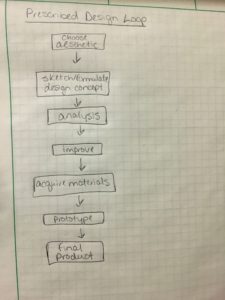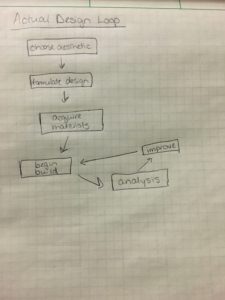I find that I like to plan things out in a very succinct, organized way, which I can probably attribute to the engineering background provided to me over the last few years. However, I also find that I become very nit-picky when something doesn’t go the way I imagine it to, which results in multiple, somewhat random design iterations. Both observations are reflected in the design loop that I prescribed myself and the one that I actually followed while creating my Upcycle project.
I struggled quite a bit initially to even come up with an idea for an Upcycle project. I imagined just sort of throwing “stuff” together until it resembled something useful or aesthetically pleasing. Stuff is in quotes because I really had no clue what kind of materials I wanted to use either. I think this is a good realization because it validates the exploration of design: there is no one right way to create something!
When I finally decided to create a sort of Steampunk-style jellyfish, I classified it as something whimsical that I could experiment with the design of. The featured image above displays all the materials that I began designing and building with. I had ideas for what I wanted to do to create structural integrity. I had ideas for what I wanted to do to create the appropriate aesthetic at first glance. However, I came to find that not all things worked quite as well as I thought they would. So I began with the prescribed design loop on the left below, expecting to at least roughly follow it. Although I did roughly follow it, there were some modifications made shown in the loop on the right. These changes account for the iterative design process of just starting to build upon something and then realizing that it wasn’t what I thought it would be.




3 Comments. Leave new
I really like how your actual design loop changed from the original design loop/. This is a unique idea and definitely uses the upcycle aesthetics. You also went into a lot of detail about how you came up with the idea, but more detail on how you will produce your final piece would also be nice.
The difference between your prescribed and actual design loops is actually interesting, if you think about how this applies in real design. Your prescribed loop relies on your design concept for analysis, or in other words, you’re basing success on your model rather than on the actual product as you’ve done in your actual design loop. I think the reality is probably a bit of a blend of the two (although mechies probably gravitate toward the prototype-first-ask-questions-later model more often than not!).
I will be interested to see what the final project is, given that the creation phase itself is pretty iterative, seeming that it will be changed as you encounter things that don’t work or things that work better than expected along the way. Do you still have plans to attach small metal bits to the outside? It seems the jellyfish could turn out very different than your original vision, which makes sense not only from a craftsman perspective but also since the project is about recycling and upcycling materials, which is changing them from their original intent to serve another purpose. You’ll almost be recycling your first draft to create your second draft, etc.!